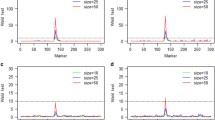Abstract
Near-isogenic lines (NILs) are a valuable resource for detecting linkages between qualitative trait loci and molecular markers. Molecular marker studies are expensive and methods that require genotyping fewer individuals, such as the NIL-analysis method, are desirable. We present a theory for using sets of NILs to detect linkages between molecular markers and introgressed loci. The probability that a marker a specific distance from the introgressed gene will have a donor parent allele in a near-isogenic line is a function of the distance between the marker and the gene, and the number of back-crosses and/or selfs used in deriving the NIL. The binomial probability formula is used to calculate the probability of having a donor parent allele at a given marker when sets of NILs are used. The formulae given allow calculation of the probability that a marker is linked to the introgressed gene, as well as the probability that a gene will be successfully detected when using given numbers of NILs, backcrosses, and molecular markers.
Similar content being viewed by others
References
Allard RW (1960) Principles of plant breeding. John Wiley, New York
Fehr WR (1987) Principles of cultivar development. MacMillan, New York
Haldane JBS (1919) The combination of linkage values, and the calculation of distance between the loci of linked factors. J Genet 8:299–309
Kosambi DD (1944) The estimation of map distance from recombination values. Ann Eugen 12:172–175
Michelmore RW, Paran I, Kesseli RV (1991) Identification of markers linked to disease-resistance genes by bulked segregant analysis: A rapid method to detect markers in specific genomic regions by using segregating populations. Proc Natl Acad Sci USA 88:9828–9832
Muehlbauer GJ, Specht JE, Thomas-Compton MA, Staswick PE, Bernard RL (1988) Near-isogenic lines — a potential resource in the integration of conventional and molecular marker linkage maps. Crop Sci 28:729–735
Muehlbauer GJ, Specht JE, Staswick PE, Graef GL, Thomas-Compton MA (1989) Application of near-isogenic line mapping technique to isozyme markers. Crop Sci 29:1548–1553
Muehlbauer GJ, Staswick PE, Specht JE, Graef GL, Shoemaker RD, Keim P (1991) RFLP mapping using near-isogenic lines in the soybean [Glycine max (L.) Merr.]. Theor Appl Genet 81:189–198
Paterson AH, Deverna JW, Lanini B, Tanksley SD (1990) Fine mapping of quantitative trait loci using selected overlapping recombinant chromosomes in an interspecies cross of tomato. Genetics 124:735–742
Weir BS (1990) Genetic data analysis. Sinauer, Sunderland, Mass.
Author information
Authors and Affiliations
Additional information
Communicated by F. Salamini
Rights and permissions
About this article
Cite this article
Kaeppler, S.M., Phillips, R.L. & Kim, T.S. Use of near-isogenic lines derived by backcrossing or selfing to map qualitative traits. Theoret. Appl. Genetics 87, 233–237 (1993). https://doi.org/10.1007/BF00223770
Received:
Accepted:
Issue Date:
DOI: https://doi.org/10.1007/BF00223770




